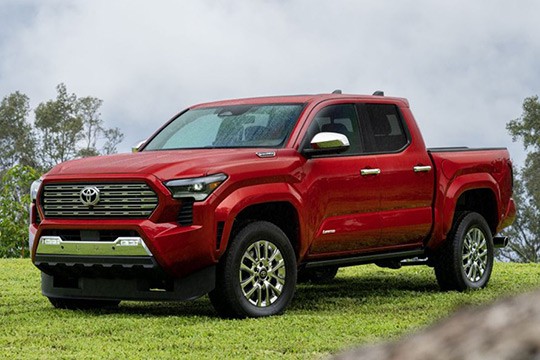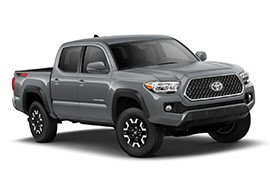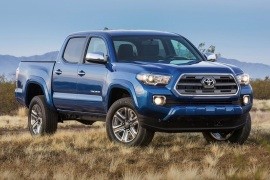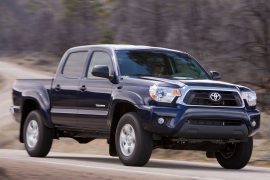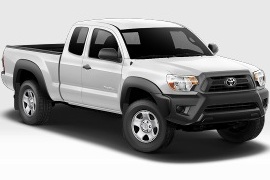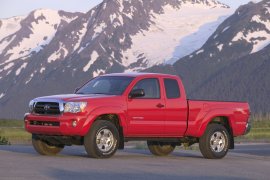TOYOTA Tacoma Models/Series Timeline, Specifications & Photos
First production year: 2005
Engines: Hybrid gasoline, Gasoline
Body style: Truck
The Toyota Tacoma burst into the market in 1995 as a compact pickup truck. Throughout the next two generations, the Japanese carmaker shifted toward a more extensive body for the car, classifying it as a mid-size pickup truck.
The 2024 model marks the start of the fourth Tacoma generation, and it is meant to continue the legacy of one of the most renowned pickup trucks in the North American market in the past couple of decades. It will be available in multiple grades, namely: SR, SR5, TRD PreRunner, TRD Sport, TRD Off Road, Limited, TRD Pro, and Trailhunter.
While inheriting the "Tacoma-ness" from its predecessors, the new version is the first one built on the TNGA-F global truck platform, being also resketched from the ground up. The boxier stance gives the car a more modern off-road look, underlining its off-road capability. A new multi-link rear suspension replaces the old leaf springs, helping increase the handling and stability of the truck, while the TRD Off-Road grade will be equipped with Bilstein remote reservoir monotube shocks to improve heat dissipation.
Improving the power of the car to match the handling abilities was a must, and Toyota did that by adding the option of the iForce MAX hybrid powertrain, which can develop 326 horsepower and 465 lb-ft of torque to help overcome even the biggest obstacles in an off-road adventure. If there is a need the electronically activated locking rear differential can do a 50/50 power split to the rear wheels.
Toyota also offers a six-speed intelligent manual transmission with automatic rev-matching and anti-stall technology for people who want a more in-depth feeling of their truck when they are off the road. To improve overall driving on all sorts of terrain the TRD Pro grade is equipped with an IsoDynamic Performance Seat which allows for simultaneous vertical and lateral movements that aim to reduce the vibrations and shocks transferred to the driver, for a smoother and less tiring drive.
The Trailhunter grade is meant to be an overlanding rig that requires no further modifications for offering one of the best experiences on the market. It comes with an Adaptive Variable Suspension, an integrated high-output air compressor, and a heavy-duty version of the bed rack that can support additional weight from a tent or any other type of camping necessity.
For a complete experience, the 2024 Tacoma has, besides a 14-inch high-quality touchscreen, a premium JBL 10 speakers' system, paired with a JBL Bluetooth speaker that acts like a center speaker when it's docked in the car and can also be undocked and used for up to six hours to entertain tailgate parties, off-road camping adventures and many more scenarios where the truck becomes the center of a social gatherings.
The Toyota Tacoma nameplate was first produced in 1995. Since then, the Tacoma model has come a long way.
With 2 gasoline engines, a 2.7-liter DOHC 4-cylinder with 159 horsepower and 180 lb-ft of torque, and an available 3.5-liter V6 with 278 horsepower and 265 lb-ft of torque, the new Toyota Tacoma Double Cab comes with an exterior facelift and new features and technologies, including sequential LED/DRL headlamps, 16-inch wheel design, black-insert taillamps highlighting the exterior changes, Apple CarPlay, Android Auto and Amazon Alexa capability. Both engines are connected to a 6-speed electronically-controlled automatic gearbox (ECT-i), although the V6 can be teamed with a 6-speed manual transmission. The latter one comes with the tow package, including a Class IV receiver hitch, automatic transmission fluid cooler, engine oil cooler, power steering cooler, 130-amp alternator, 4 & 7-pin connector with convertor, and Trailer-Sway Control.
The Toyota Tacoma Double Cab comes with more than 30 configurations in six version grades available, meeting any requirement: work-ready SR, high-style, high-value SR5, athletic TRD Sport, adventurous TRD Off-Road, ultimate off-road TRD Pro and top-of-the-line Limited. With the proper equipment, the Toyota Tacoma Double Cab can pull up to 6,800 lbs.
This 2015 off-road pick-up is recognized as one of the best-in-class pickups in the world. Big, tough and capable, it can conquer the desert, Baja or parking lots. Also, it is one of the most sought-after vehicles for contractors. The 2016 Tacoma was developed by the Toyota engineering team at Toyota Technical Center in Ann Arbor, Michigan.
Starting from the chassis, engineers added high strength steel to enhance rigidity. To create a truck to meet the needs of active drivers on a variety of tamed and untamed surfaces, the suspension was tuned to deliver a comfortable on-road ride, but strong enough for off-roading.
The Tacoma can be ordered with either a four-cylinder 2.7-liter or with a smoother 3.5-liter V6 engine. Both are offered as standard with a six-speed automatic transmission, but the V6 may be ordered optionally with a 6-speed manual transmission.
The Tacoma may be configured with 4x2 or 4x4 wheel-drive. Additional off-road technology includes Automatic Limited Slip and Locking Rear Differential, Hill Start Assist Control (HAC), Clutch Start Cancel (manual transmission only), Active Traction Control, and Crawl Control. Engaging Crawl Control allows the driver to select a speed of 1-5 mph.
For the comfort side, the 2017 Tacoma may be ordered with a touch-screen infotainment system, wireless charger, leather seats, and sunroof.
The Tacoma was the best-selling compact pickup on the U.S. market in 2010, and Toyota tried to keep the momentum by introducing a facelifted version in 2011 for the 2012 model year.
Back in 2010, the Tundra was the best-selling compact pickup on the U.S. market, outselling its closest competitor by nearly two to one. But that outstanding result didn't make Toyota pop the champagne and call it a good year. Instead, it sent its engineering team back to its labs to improve the vehicle. In 2011, it offered it with the same cab choices and improved the standard equipment for the Double-cab version.
The Double-cab version was the one fit for the whole family and still able to do some work. Maybe it couldn't carry as much stuff in the bed as its siblings, but it could take five people inside. Its rear doors featured an ascending line towards the C-pillar, disrupting the straight beltline look.
Inside, depending on the options, it provided a black center console, switch plate, dashboard, and doors. For the SR5 version, Toyota added a new fabric design for the seats, while the TRD package (sport package) came with water-resistant upholstery. The Japanese carmaker added more audio systems, including an infotainment unit with navigation and the Toyota Entune service. Even the base version of the Double-cab featured power windows for all doors, and the carmaker added an option to open the middle section of the rear windscreen.
Like its siblings, the Tundra Double-cab received a choice of two engines: an inline-four and a V-6. Both were available with either a rear or four-wheel-drive system and a two-speed transfer case.
The Tacoma was the best-selling compact pickup on the U.S. market in 2010, and Toyota tried to keep the momentum by introducing a facelifted version in 2011 for the 2012 model year.
While the Tacoma didn't necessarily need a facelift, the carmaker did it anyway. Thus, it could show a revised front fascia and make new billboards where it bragged about its results. It was a rugged vehicle fit as a workhorse and friendly as a family car. But the Access Cab was more of a work truck.
The single-cab version was a working vehicle fit to carry a lawnmower in the bed and other tools for a two-people-job. With the Access-Cab, it was different. It could get four people inside, but only for short distances or if those in the back had shorter feet. Its rear-hinged rear doors helped them getting in and out more quickly. At the back, it featured a bed fit for a ton of bricks.
Inside, depending on the options, it provided a black center console, switch plate, dashboard, and doors. For the SR5 version, Toyota added a new fabric design for the seats, while the TRD package (sport package) came with water-resistant upholstery. The Japanese carmaker added more audio systems, including an infotainment unit with navigation and the Toyota Entune service.
Under the hood, the Tundra Access cab offered two engine choices that provided 171 hp or 239 hp. Toyota paired them with either a five-speed manual or a four-speed automatic, with rear or 4x4 systems with a high and low-range transfer case.
All-new for 2005, the Tacoma was already at its 6th generation, with the first generation released in 1995.
Considered a major improvement compared to the previous version, the Tacoma featured improved engine performance, increased interior room and many new safety features.
Specific to most trucks in the class, the new Tacoma was available in an extended cab or a crew cab body styles, with both two-wheel-drive or four-wheel drive systems offered.
Available with a choice of two engines, the regular and the access cab models were driven by a 4-cylinder or a 6-cylinder engine, while the crew cab body style was only available with a V6 engine.
The old 2.4-liter and 2.7-liter powerplant were replaced by an all new 2.7-liter unit that developed 164 hp and 183 pound-feet of torque.
The V6 unit was a new 4.0-liter engine that replaced the old 3.4-liter and boasted 245 hp and 283 lb.-ft of torque.
Safety wise, the Tacoma was equipped with Electronic Brake Distribution with brake assist as standard. Optionally, a stability control system could be added, with the exception of the X-Runner. Hill-start assist control and downhill assist control were on the list of optional safety features available only with the Tacomas equipped with an automatic transmission.
The interior design was reminiscent of the Toyota’s 4Runner SUV, while the materials’ quality was improved. The seats became more comfortable and supportive, rather surprising for a vehicle in this class.
